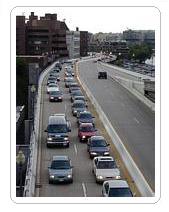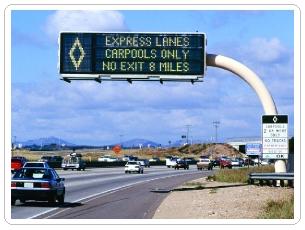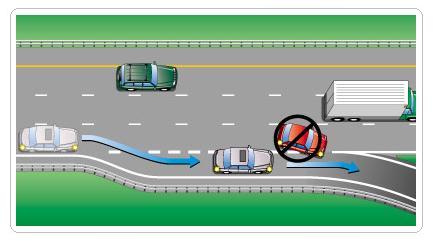|
|
|
|
FREEWAY DRIVING
Freeway trip planning You should know how to:
Freeway, entering using acceleration lanes Freeway entrances are identified with signs. In most cases, once an on-ramp is entered you must proceed onto the freeway. Do not stop in the acceleration lane unless due to traffic congestion. Traffic will not expect you to stop and you could cause an accident. On-ramps may have special posted speed limits these are usually cautionary but should be obeyed since they are there for a reason, i.e. extreme curve. You must be alert to sudden stops by traffic already on the freeway and be prepared to slow down as you merge. Locate a gap in the freeway traffic. You need a 4 second gap in the freeway traffic to merge into the freeway. That will give you and the car behind you a 2 second following distance. Do not try to squeeze into a gap that is too small. Leave yourself a big enough space cushion. Watch for vehicles around you. Use your mirrors and turn you head to look quickly to the side before changing lanes or merging into the freeway lane. If you need to cross several lanes, take them one at a time. Do not stop to wait until lanes are clear this could cause an accident. Enter the freeway at approximately the same speed as traffic making sure you have enough room to merge safely (Remember the maximum speed allowed is 65 mph on most freeways). You must signal as you start to merge into traffic and should continue to signal until you are fully merged. Freeway, mistakes made in using acceleration lanes Remember: traffic on the freeway has the right-of-way. It is dangerous to suddenly slow or stop in an acceleration lane or on-ramp, and merge into traffic at a speed that is too slow or fast for the flow of traffic. Freeway, no acceleration lanes When entering a freeway without an acceleration lane, you must check for yield or merge signs before entering. You may need to slow down in order to give yourself sufficient time to judge the best place to merge and to find a gap in traffic. It may be necessary to stop in these instances in order to merge safely. Accelerate sufficiently to blend into traffic. Enter the freeway at approximately the same speed as the speed of traffic. Special situations. Timed entrance lights provide a gap between vehicles which reduces the likelihood of sudden stops and congestion. Some of these lights will only allow 1 car per lane to go at a time, others will allow 2 per lane. Double merge lanes allow traffic on high volume on-ramps to create gaps which allow vehicles to merge safely and may also include lanes marked for carpools. Carpool lanes will not have a meter light. Diamond lanes Freeway carpool lanes:
Leaving the freeway When you plan to exit a freeway, you should scan well ahead of time for signs indicating which lane to use when exiting a freeway so as to avoid last minute, sudden lane changes. If you miss your exit, continue on to the next exit. Do not pull to the shoulder and attempt to back up or turn if you miss your exit. You should never attempt to back up on the freeway, this is extremely dangerous.
If you can not exit safely, proceed to the next exit.
Know your freeway exit and give yourself plenty of time to get over. Signal your intention to exit for approximately 5 seconds. Be sure you are at the proper speed for leaving traffic - not too slow or too fast (so that you won't lose control). Cross merge lanes allow traffic entering and exiting the freeway to use the same lane. Be especially alert when using these types of ramps and give the merging traffic room to safely enter or exit. Freeway, exit lanes Freeway exit lanes provide you:
Deceleration lanes on the freeways allow drivers to reduce speed prior to exiting without endangering traffic to the rear. Signal your intention to make lane change at least 100 ft. in advance. Slow down gradually, and when you're sure it's safe and clear, move over to the far right lane and proceed to exit.
If you see a driver trying to get into the deceleration lane ahead, slow down and give space to the driver to get into the lane. While making the exit, follow the posted speed limit signs. Many engineering hours have gone into determining the safe speed at which you should exit. Some of the off-ramps have extreme curves. If you're driving too fast, you're likely to lose control of the vehicle and hit the ramp or another vehicle. Freeway, lane choice Use of right and left lane on two lane freeway The right-hand lane on a freeway is for slower moving traffic and left lane is for faster traffic. Move to a slower lane if a vehicle is following closely behind you, even if you are obeying the speed limit. Left lanes should be used for passing slower moving vehicles. If you are driving a bus, towing a trailer or another vehicle, or driving a large truck, you must use the right lane or a lane specifically marked for slower-moving vehicles. Use of right, left and center lane on multi-lane freeways The right lane on a multi-lane freeway is for slower moving traffic. Some times the first two right lanes might be designated for slower vehicle, like busses and trucks. Leftmost lane is for faster traffic and for passing slower moving vehicles. Center lane usually provides the most smooth traffic flow. Center lane also protect drivers from traffic merging into the freeway and from vehicle exiting the freeway. To avoid merging conflicts when approaching interchanges , you should move into the center lanes on the freeways. When approaching an interchange, you should anticipate and move well in advance into the lane you will need to take. You may need to change lane to avoid conflict with traffic merging into the freeway. Avoid using lanes that are inappropriate for your speed. You can be cited for unnecessary lane changes and weaving in and out of traffic lanes. Speed limits There are maximum speeds set for safety. The "basic speed law" states that you must never drive faster than is safe for the existing weather and highway conditions, regardless of the posted speed limit. The maximum speed in most states is 65 MPH except:
You must adjust speed to weather conditions. For example, you should driver slower in the fog because the distance you can see ahead is reduced, and slower in the rain or snow because it takes longer to stop your vehicle. All posted speed limits are based on ideal driving conditions. You must adjust your speed of travel to roadway, traffic, and weather conditions. It is illegal to block normal and reasonable movement of traffic by going too slow. You should not drive in the fast lane if you are driving slowly relative to other vehicles. You could be cited for speeding when going the speed limit, or even under the speed limit, if your speed is still deemed to be too fast for the road, weather, or traffic conditions. This is part of the "basic speed law". Establishing and maintaining a safe space cushion On freeways and other roads where speed is high, a 5-second gap between vehicles is appropriate. Allow extra room between your vehicle and the one ahead if you are being tailgated. Avoid driving alongside of other vehicles or in their blind spot. The driver next to you may suddenly change lanes into you. Do not assume other drivers are driving defensively. It is against the law to follow at a distance which is too close given the traffic and road conditions; you can be cited for tailgating. Helping other drivers to safely merge Be aware of signs warning of merging traffic. Even though you may have the right-of-way, accidents are avoided by adjusting your speed and/or changing lanes so as to open a gap for merging vehicles. Freeway emergencies To safely drive on freeways:
Freeway breakdowns If you lose power or have an equipment failure on a freeway:
If your vehicle is parked, stopped, or left standing on a freeway for more than four hours, it may be removed by law enforcement or you may be issued a citation. Reentering freeway from shoulder If you must enter a freeway lane from the shoulder:
You must yield to traffic as you reenter a highway after being parked. Special freeway problems Velocitation unconsciously going too fast You must guard against unconsciously going too fast by checking your speedometer regularly since other traffic may be speeding and you may not realize how fast you are actually driving. Highway hypnosis- avoiding drowsiness It is easy to become transfixed or drowsy when driving on freeways. Always be alert to your surroundings. Falling asleep at the wheel is a major cause of fatal accidents. Do not drive if you are feeling tired or sleepy or have taken medication that makes you drowsy. Toll booths and check points Reduce your speed when approaching toll booths, immigration check points, and other inspection stations. Signs are usually posted a mile or more in advance to warn you. Be alert for them and prepare to stop. Use lanes designated for your type of vehicle. Lanes are marked for carpools, trucks, and buses. You must correctly judge the stopping distance involved as you approach.
|
 Content
Of Online Course
Content
Of Online Course


